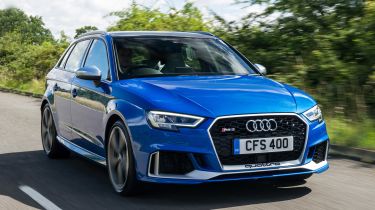Audi RS 3 (2014-2017) review - Practicality, comfort and boot space
The Audi RS3's mix of potent performance and family-friendly practicality is hard to beat

Few cars at the RS 3’s level of performance offer such a practical layout. Available in two body styles, the more practical model is the conventional Sportback. With five seats, five doors and a versatile hatchback layout, it's almost as versatile as the standard A3 – although the boot capacity of 335-litres is 45 litres less than the standard A3 Sportback.
Inside, deep door bins and lots of cubby holes and cupholders make the most of the available space. There's also a large glovebox and a deep lidded compartment between the front seats. Speaking of which, the Audi’s wingback sports seats don’t just look fabulous – they’re comfortable and supportive too, with a driving position that’s adjustable for all shapes and sizes.
The RS 3 Saloon is impressively practical, too, though the lidded boot is means the raw numbers are a little deceptive. Like its hatchback sibling, the 315-litre loadbay is smaller than the standard A3 Saloon's – though in this model you lose a whopping 100 litres of carrying capacity.
Elsewhere, the firmer suspension naturally makes the RS 3 that little bit more tiresome than an A3 diesel on long journeys and over poor surfaces. But with its surfeit of power and quiet cabin when cruising, the RS 3 is nonetheless well suited to long road trips. Just be aware that you’ll be stopping to top up with fuel fairly often, as the standard A3 fuel tank is a fairly modest 55 litres.
Size
The RS 3 Sportback is 4,335mm long and 1,800mm wide, which puts it on par with the Mercedes-AMG A45. At 4,479mm, the RS 3 saloon is a bit longer than the Sportback, while the lengthier rear overhang makes parking trickier.
Leg room, head room & passenger space
Audi has added an extra 35mm to the RS 3's wheelbase (the distance between front and rear axles) over the three-door A3, which frees up some welcome legroom in the rear – even six-footers will be comfortable back there.
While the car is a full five-seater, two rear passengers will be much more comfortable than three because shoulder-room will otherwise be severely limited. There are standard ISOFIX child seat mounts on the front passenger seat and the two outer rear seats.
Boot
This is where the Audi's practicality credentials take a hiding. The standard A3 Sportback boasts a useful 380-litre capacity, but the RS 3 can only accommodate 335 litres, which is only slightly larger than some superminis. This reduction is a result of the need surrender underfloor space for the four-wheel drive system's back axle and the battery (the large five-cylinder engine means there's not enough space under the bonnet).
Drop the rear seats and the usable loading area jumps to 1,175 litres – which is more than the Mercedes-AMG A45 can offer. There’s a decently low loading lip too, while the Sportback’s estate car-like lines help to maximise practicality.
The RS 3 Saloon is smaller still, at 315 litres. The seats split and fold as standard, but Audi hasn't issued a total boot space volume figure.








